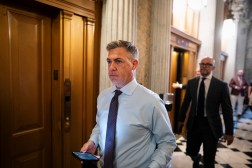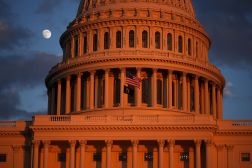AI Corps leader leaves Homeland Security for US Digital Response

Michael Boyce, the inaugural leader of the Department of Homeland Security’s AI Corps, has left the position and joined U.S. Digital Response, a nonprofit that works with government agencies on technical projects on a pro-bono basis.
Boyce, who stepped down from DHS in April, said in an interview with FedScoop that he’ll be an AI lead and generative AI technologist in residence at USDR focused on helping state and local governments deploy artificial intelligence, drawing on lessons learned from his time at DHS.
“The core idea is that State and local agencies face the same questions I saw at the federal level — How do we vet vendors? How do we safeguard data? Where will AI really help residents and the public? — but they rarely have in-house experts or big consulting budgets,” he said in emailed comments. “My job is to bring the delivery mindset, technical know-how, and hard-won lessons from DHS and other federal programs to partners, so even a two-person technology shop can deploy AI as confidently as a cabinet-level agency.”
He hopes to help assemble experts that can work with leaders in local and state government and deliver a technical service — which could be a particular product or assistance with testing and evaluation help — within just a few months.
Tina Walha, CEO of USDR, said in a statement to FedScoop that “state and local governments are eager to use generative AI responsibly, but they need trusted, unbiased guidance, not vendor pitches. … Every government — from major cities to rural communities — deserves access to these transformative capabilities. This is about making sure generative AI serves the public good, not just the privileged few.”
Boyce’s exit comes amid an exodus of tech talent throughout the Trump administration, which has focused on reducing the workforce and pivoting from the top priorities of the Biden administration. While both administrations have focused on artificial intelligence, they’ve taken different tacks.
AI Corps was a tech talent hiring sprint launched in 2024 and implemented under previous DHS Secretary Alejandro Mayorkas. The program received more than 14,000 job applications and had brought on about 50 staffers by the beginning of the Trump administration, Boyce said.
The program succeeded, Boyce argued, and collaborated with many DHS components, including Immigration and Customs Enforcement, Customs and Border Protection, and United States Citizenship and Immigration Services, as well as the Office of Procurement at headquarters. Last winter, the Corps helped release DHSChat, a generative AI platform that the department recently encouraged staffers to use instead of commercial generative AI platforms. Boyce said early surveys of the tool showed it saved workers, on average, 30 minutes a day.
Boyce said that while the AI Corps had made significant progress, under the new administration he felt the “opportunities narrowing to deliver AI in the iterative, user-focused way that I care about.” A number of people in the AI Corps resigned or took the deferred resignation offer. He emphasized no staff were fired while he was there.
“In many ways, it is normal for a new administration’s priorities to take a little while to form around issues,” Boyce said. “The difference in my experience this time around was the energy spent focused on the civil service itself. With the uncertainty caused by the focus on the organization itself, there was limited opportunity to have the conversations needed to solidify those long term plans and how they aligned with the administration’s broader policy priorities.”
Abigail Haddad, a machine-learning engineer who recently left the AI Corps, told FedScoop she resigned because it “wasn’t a good environment due to broader issues at DHS and across the federal government.”
Boyce emphasized that the government’s prospects for AI adoption hinge on access and talent. Staff, he argues, need to have generative AI available within their workflows, not limited to specific applications. Blocking certain AI websites, as many federal agencies did, makes less and less sense as search engines integrate generative AI into results.
“To get this talent, we met candidates where they were,” Boyce noted. “We leveraged Direct Hire authority to not only have robust assessments and subject matter expert review, but we also used plain language job titles: our positions were posted as ‘AI Technology Expert’ and we clearly defined our roles — I think the AI Corps may have been the first federal agency to use ‘Staff Software Engineer’ as a title in one of its postings.”
Boyce said he sees his next job as a natural next step in his public service journey, working with many different government departments instead of a single agency. He also said he’ll focus on helping local and state officials connect with AI experts.






